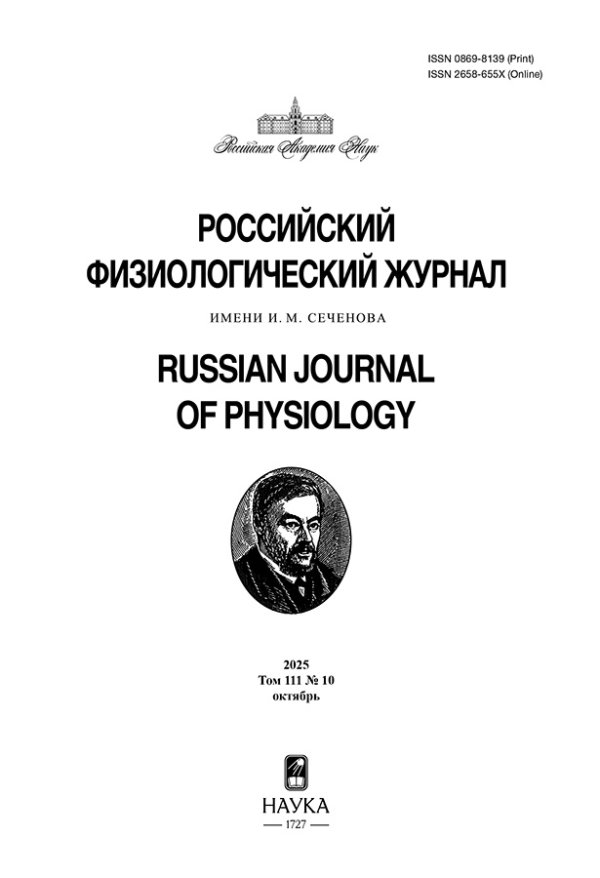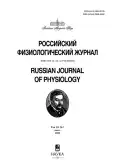Влияние умеренно гипоксических условий культивирования мезенхимальных стромальных клеток на иммунологические показатели при заживлении матки крыс
- Авторы: Тихонова Н.Б.1, Темнов А.А.2, Алексанкина В.В.1, Фокина Т.В.1, Алексанкин А.П.1, Склифас А.Н.2, Кузнецова Е.В.1, Милованов А.П.1, Михалева Л.М.1
-
Учреждения:
- Российский научный центр хирургии им. акад. Б.В. Петровского
- Пущинский научный центр биологических исследований РАН – обособленное подразделение Института биофизики клетки РАН
- Выпуск: Том 111, № 7 (2025)
- Страницы: 1101-1116
- Раздел: ЭКСПЕРИМЕНТАЛЬНЫЕ СТАТЬИ
- URL: https://gynecology.orscience.ru/0869-8139/article/view/691435
- DOI: https://doi.org/10.7868/S2658655X25070061
- EDN: https://elibrary.ru/mvrbmq
- ID: 691435
Цитировать
Полный текст
Аннотация
Ключевые слова
Об авторах
Н. Б. Тихонова
Российский научный центр хирургии им. акад. Б.В. Петровского
Email: morpholhum@list.ru
Москва, Россия
А. А. Темнов
Пущинский научный центр биологических исследований РАН – обособленное подразделение Института биофизики клетки РАНПущино, Россия
В. В. Алексанкина
Российский научный центр хирургии им. акад. Б.В. ПетровскогоМосква, Россия
Т. В. Фокина
Российский научный центр хирургии им. акад. Б.В. ПетровскогоМосква, Россия
А. П. Алексанкин
Российский научный центр хирургии им. акад. Б.В. ПетровскогоМосква, Россия
А. Н. Склифас
Пущинский научный центр биологических исследований РАН – обособленное подразделение Института биофизики клетки РАНПущино, Россия
Е. В. Кузнецова
Российский научный центр хирургии им. акад. Б.В. ПетровскогоМосква, Россия
А. П. Милованов
Российский научный центр хирургии им. акад. Б.В. ПетровскогоМосква, Россия
Л. М. Михалева
Российский научный центр хирургии им. акад. Б.В. ПетровскогоМосква, Россия
Список литературы
- Kosaric N, Kiwanuka H, Gurtner GC (2019) Stem cell therapies for wound healing. Expert Opin Biol Ther 19(6): 575–585. https://doi.org/10.1080/14712598.2019.1596257
- Raghuram AC, Yu RP, Lo AY, Sung CJ, Bircan M, Thompson HJ, Wong AK (2020) Role of stem cell therapies in treating chronic wounds: A systematic review. World J Stem Cells 12(7): 659–675. https://doi.org/10.4252/wjsc.v12.i7.659
- Abdel-Gawad DRI, Moselhy WA, Ahmed RR, Al-Muzafar HM, Amin KA, Amin MM, El-Nahass ES, Abdou KAH (2021) Therapeutic effect of mesenchymal stem cells on histopathological, immunohistochemical, and molecular analysis in second-grade burn model. Stem Cell Res Ther 12(1): 308. https://doi.org/10.1186/s13287-021-02365-y
- Zhou J, Shi Y (2023) Mesenchymal stem/stromal cells (MSCs): origin, immune regulation, and clinical applications. Cell Mol Immunol 20(6): 555–557. https://doi.org/10.1038/s41423-023-01034-9
- Egger D, Tripisciano C, Weber V, Dominici M, Kasper C (2018) Dynamic Cultivation of Mesenchymal Stem Cell Aggregates. Bioengineering (Basel) 5(2): 48. https://doi.org/10.3390/bioengineering5020048
- Műzes G, Sipos F (2022) Mesenchymal Stem Cell-Derived Secretome: A Potential Therapeutic Option for Autoimmune and Immune-Mediated Inflammatory Diseases. Cells 11(15): 2300. https://doi.org/10.3390/cells11152300
- Giovannelli L, Bari E, Jommi C, Tartara F, Armocida D, Garbossa D, Cofano F, Torre ML, Segale L (2023) Mesenchymal stem cell secretome and extracellular vesicles for neurodegenerative diseases: Risk-benefit profile and next steps for the market access. Bioact Mater 29: 16–35. https://doi.org/10.1016/j.bioactmat.2023.06.013
- Ferreira JR, Teixeira GQ, Santos SG, Barbosa MA, Almeida-Porada G, Gonçalves RM (2018) Mesenchymal Stromal Cell Secretome: Influencing Therapeutic Potential by Cellular Pre-conditioning. Front Immunol 9: 2837. https://doi.org/10.3389/fimmu.2018.02837
- Volkova MV, Shen N, Polyanskaya A, Qi X, Boyarintsev VV, Kovaleva EV, Trofimenko AV, Filkov GI, Mezentsev AV, Rybalkin SP, Durymanov MO (2023) Tissue-Oxygen-Adaptation of Bone Marrow-Derived Mesenchymal Stromal Cells Enhances Their Immunomodulatory and Pro-Angiogenic Capacity, Resulting in Accelerated Healing of Chemical Burns. Int J Mol Sci 24(4): 4102. https://doi.org/10.3390/ijms24044102
- Pezzi A, Amorin B, Laureano Á, Valim V, Dahmer A, Zambonato B, Sehn F, Wilke I, Bruschi L, Silva MALD, Filippi-Chiela E, Silla L (2017) Effects оf Hypoxia in Long-Term In Vitro Expansion of Human Bone Marrow Derived Mesenchymal Stem Cells. J Cell Biochem 118(10): 3072–3079. https://doi.org/10.1002/jcb.25953
- Chistiakov DA, Killingsworth MC, Myasoedova VA, Orekhov AN, Bobryshev YV (2017) CD68/macrosialin: not just a histochemical marker. Lab Invest 97(1): 4–13. https://doi.org/10.1038/labinvest.2016.116
- Lopez-Castejon G, Brough D (2011) Understanding the mechanism of IL-1β secretion. Cytokine Growth Factor Rev 22(4): 189–195. https://doi.org/10.1016/j.cytogfr.2011.10.001
- Tanaka T, Narazaki M, Kishimoto T (2014) IL-6 in inflammation, immunity, and disease. Cold Spring Harb Perspect Biol 6(10): a016295 https://doi.org/10.1101/cshperspect.a016295
- Chatterjee P, Chiasson VL, Bounds KR, Mitchell BM (2014) Regulation of the Anti-Inflammatory Cytokines Interleukin-4 and Interleukin-10 during Pregnancy. Front Immunol 5: 253. https://doi.org/10.3389/fimmu.2014.00253
- Park DW, Yang KM (2011) Hormonal regulation of uterine chemokines and immune cells. Clin Exp Reprod Med38(4): 179–185. https://doi.org/10.5653/cerm.2011.38.4.179
- Engeland CG, Sabzehei B, Marucha PT (2009) Sex hormones and mucosal wound healing. Brain Behav Immun 23(5): 629–635. https://doi.org/10.1016/j.bbi.2008.12.001
- Hubscher CH, Brooks DL, Johnson JR (2005) A quantitative method for assessing stages of the rat estrous cycle. Biotech Histochem 80(2): 79–87. https://doi.org/10.1080/10520290500138422
- Tikhonova NB, Milovanov AP, Aleksankina VV, Fokina TV, Boltovskaya MN, Aleksankin AP, Artem'eva KA (2021) Analysis of Healing of Rat Uterine Wall After Full-Thickness Surgical Incision. Bull Exp Biol Med 172(1): 100–104. https://doi.org/10.1007/s10517-021-05340-y
- Tikhonova NB, Milovanov AP, Aleksankina VV, Fokina TV, Boltovskaya MN, Aleksankin AP (2021) The role of adipose tissue in the healing of rat uterine wall after a full-thickness surgical incision. Clin Exp Morphol 10: 72–80. https://doi.org/10.31088/CEM2021.10.4.72-80
- Temnov AA, Rogov KA, Sklifas AN, Klychnikova EV, Hartl M, Djinovic-Carugo K, Charnagalov A (2019) Protective properties of the cultured stem cell proteome studied in an animal model of acetaminophen-induced acute liver failure. Mol Biol Rep 46(3): 3101–3112. https://doi.org/10.1007/s11033-019-04765-z
- Bustin SA, Benes V, Garson JA, Hellemans J, Huggett J, Kubista M, Mueller R, Nolan T, Pfaffl MW, Shipley GL, Vandesompele J, Wittwer CT (2009) The MIQE guidelines: minimum information for publication of quantitative real-time PCR experiments. Clin Chem 55(4): 611–622. https://doi.org/10.1373/clinchem.2008.112797
- De M, Wood GW (1990) Influence of oestrogen and progesterone on macrophage distribution in the mouse uterus. J Endocrinol 126(3): 417–424. https://doi.org/10.1677/joe.0.1260417
- Huang J, Roby KF, Pace JL, Russell SW, Hunt JS (1995) Cellular localization and hormonal regulation of inducible nitric oxide synthase in cycling mouse uterus. J Leukoc Biol 57(1): 27–35. https://doi.org/10.1002/jlb.57.1.27
- Zhang L, Long W, Xu W, Chen X, Zhao X, Wu B (2022) Digital Cell Atlas of Mouse Uterus: From Regenerative Stage to Maturational Stage. Front Genet 13: 847646. https://doi.org/10.3389/fgene.2022.847646
- Furuhashi M, Saitoh S, Shimamoto K, Miura T (2015) Fatty Acid-Binding Protein 4 (FABP4): Pathophysiological Insights and Potent Clinical Biomarker of Metabolic and Cardiovascular Diseases. Clin Med Insights Cardiol 8(Suppl 3): 23–33. https://doi.org/10.4137/CMC.S17067
- Shan T, Liu W, Kuang S (2013) Fatty acid binding protein 4 expression marks a population of adipocyte progenitors in white and brown adipose tissues. FASEB J 27(1): 277–287. https://doi.org/10.1096/fj.12-211516
- Elmasri H, Ghelfi E, Yu CW, Traphagen S, Cernadas M, Cao H, Shi GP, Plutzky J, Sahin M, Hotamisligil G, Cataltepe S (2012) Endothelial cell-fatty acid binding protein 4 promotes angiogenesis: role of stem cell factor/c-kit pathway. Angiogenesis 15(3): 457–468. https://doi.org/10.1007/s10456-012-9274-0
- Steen KA, Xu H, Bernlohr DA (2017) FABP4/aP2 Regulates Macrophage Redox Signaling and Inflammasome Activation via Control of UCP2. Mol Cell Biol 37(2): e00282–16. https://doi.org/10.1128/MCB.00282-16
- Tikhonova N, Milovanov AP, Aleksankina VV, Kulikov IA, Fokina TV, Aleksankin AP, Belousova TN, Mikhaleva LM, Niziaeva NV (2023) Adipocytes in the Uterine Wall during Experimental Healing and in Cesarean Scars during Pregnancy. Int J Mol Sci 24(20): 15255. https://doi.org/10.3390/ijms242015255
- Hübner G, Brauchle M, Smola H, Madlener M, Fässler R, Werner S (1996) Differential regulation of pro-inflammatory cytokines during wound healing in normal and glucocorticoid-treated mice. Cytokine 8(7): 548–556. https://doi.org/10.1006/cyto.1996.0074
- Macleod T, Berekmeri A, Bridgewood C, Stacey M, McGonagle D, Wittmann M (2021) The Immunological Impact of IL-1 Family Cytokines on the Epidermal Barrier. Front Immunol 12: 808012. https://doi.org/10.3389/fimmu.2021.808012
- Hickey DK, Fahey JV, Wira CR (2013) Mouse estrous cycle regulation of vaginal versus uterine cytokines, chemokines, α-/β-defensins and TLRs. Innate Immun 19(2): 121–131. https://doi.org/10.1177/1753425912454026.
- Vicetti Miguel RD, Quispe Calla NE, Dixon D, Foster RA, Gambotto A, Pavelko SD, Hall-Stoodley L, Cherpes TL (2017) IL-4-secreting eosinophils promote endometrial stromal cell proliferation and prevent Chlamydia-induced upper genital tract damage. Proc Natl Acad Sci U S A 114(33): E6892–E6901. https://doi.org/10.1073/pnas.1621253114
- Salmon-Ehr V, Ramont L, Godeau G, Birembaut P, Guenounou M, Bernard P, Maquart FX (2000) Implication of interleukin-4 in wound healing. Lab Invest 80(8): 1337–1343. https://doi.org/10.1038/labinvest.3780141
- Lopez MC, Stanley MA (2005) Cytokine profile of mouse vaginal and uterus lymphocytes at estrus and diestrus. Clin Dev Immunol 12(2): 159–164. https://doi.org/10.1080/17402520500141010
- Sun Q, Tang L, Zhang D (2023) Molecular mechanisms of uterine incision healing and scar formation. Eur J Med Res 28(1): 496. https://doi.org/10.1186/s40001-023-01485-w
- De M, Sanford TR, Wood GW (1992) Interleukin-1, interleukin-6, and tumor necrosis factor alpha are produced in the mouse uterus during the estrous cycle and are induced by estrogen and progesterone. Dev Biol 151(1): 297–305. https://doi.org/10.1016/0012-1606(92)90234-8
- Singampalli KL, Balaji S, Wang X, Parikh UM, Kaul A, Gilley J, Birla RK, Bollyky PL, Keswani SG (2020) The Role of an IL-10/Hyaluronan Axis in Dermal Wound Healing. Front Cell Dev Biol 8: 636. https://doi.org/10.3389/fcell.2020.00636
- Johnson BZ, Stevenson AW, Prêle CM, Fear MW, Wood FM (2020) The Role of IL-6 in Skin Fibrosis and Cutaneous Wound Healing. Biomedicines 8(5): 101. https://doi.org/10.3390/biomedicines8050101. PMID: 32365896; PMCID: PMC7277690
- Kodunov A, Temnov A, Tereshchenko A, Trifanenkova I, Sklifas A, Shatskikh A (2022) Mechanisms of the influence of conditioned medium of cultured stem cells on the development of pathological angiogenesis in the eye cornea in experiment. Patogenez (Pathogenesis) 19(4): 41–52. https://doi.org/10.25557/2310-0435.2021.04.41-52
Дополнительные файлы








